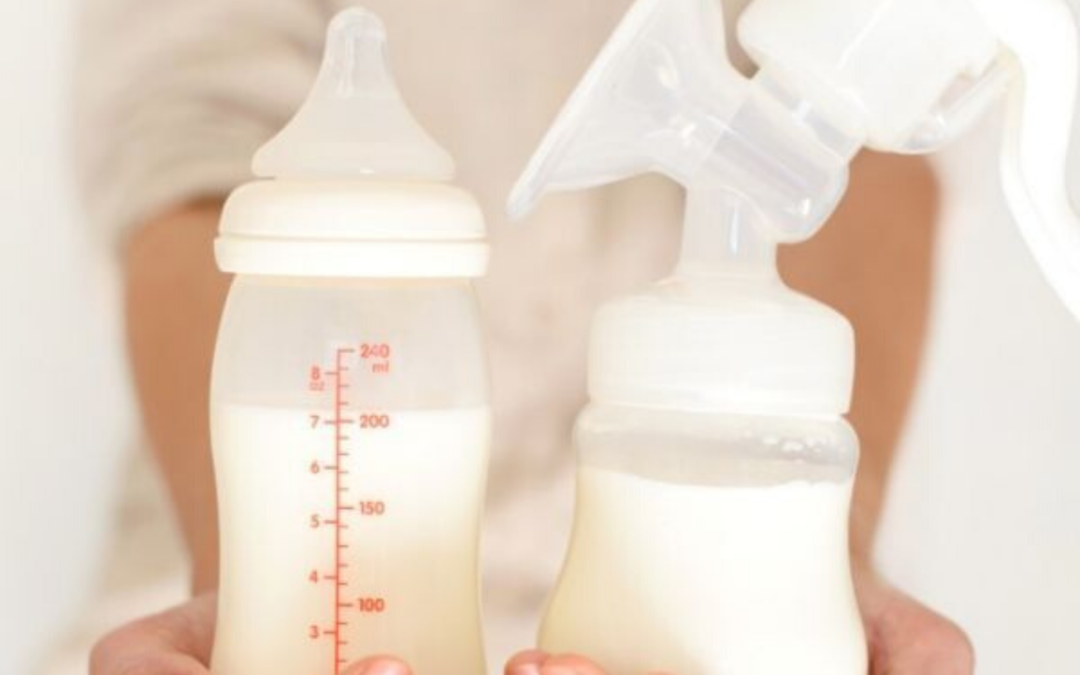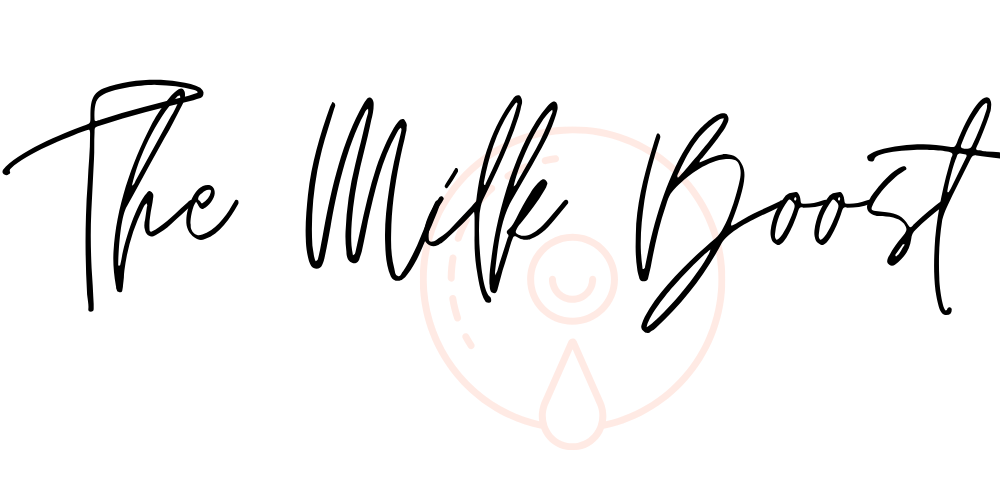
The breastfeeding basics for first-time moms that will save newmommies stress, frustration and low milk supply. This post is written by Andrea Tran, an RN, BSN, MA and IBCLC. She has been working with breasetfeeding mamas for over 25 years, and has some very valuable expertise to share with The Milk Boost community.
Written by Andrea Tran RN, BSN, MA, IBCLC
Breastfeeding is the natural way to feed your baby. That does not mean it will come naturally. For first time moms, this will be new territory. Add in the fact that every baby and mom is unique, and it is easy to understand why it can be an overwhelming and confusing time.
As a new breastfeeding mom, you will have lots of questions. There is a lot to learn. It is always a good idea to start with the basics. These breastfeeding basics for first-time moms will help get you off to a good start.
Do Skin to Skin Right Away
Skin to skin has an amazing effect on both babies and moms. It has an abundance of research demonstrating its benefits (Source).
- Encourages early breastfeeding.
- Increases the likelihood that a baby will exclusively breastfeed.
- Helps babies stabilize their temperature
- Helps babies stabilize their blood sugar
When doing skin to skin, your baby should be laid against you. Her shoulders, chest, and tummy should be facing you. Her head should be turned to one side, and you should be able to see her face.
If you are unable to have skin to skin time when your baby is first born, do it as soon as you can.
Don’t limit skin-to-skin to the period right after birth. Do it as much as you can in those first few days.
Breastfeed As Soon As Your Baby Wants To
Don’t expect your baby will want to latch as soon as he is born. However, most babies will be ready to breastfeed after they have had some time to take in their new surroundings.
Your baby will let you know that he is ready for that first breastfeeding session. Just watch for his feeding cues.
Learn Your Baby’s Feeding Cues
- Smacking lips
- Sticking out tongue
- Opening and closing mouth
- Rooting: turning her head toward you and opening her mouth.
Breastfeeding Positions
Most mamas are in bed the first time their baby wants to breastfeed. Make sure that you get comfortable. Use pillows to support your baby and your arms.
There are four common positions to nurse in. In all the positions, your baby should be turned in toward your body. You want him to be able to latch without having to turn his head to the side.
Cradle Hold
This is probably the most familiar position. It is not necessarily the best one to start with, though. I like to say it’s an “advanced” position. It will feel more comfortable when you and your baby have a bit more breastfeeding experience.
In the cradle hold position, you will hold your baby in the crook of your arm. You offer the breast that is on the same side as the arm you use to hold your baby. Use your opposite hand to hold your breast.
Cross Cradle Hold
This is a position that gives you a lot of control. You hold your baby with the arm that is opposite of the breast you offer. Hold your breast with the same hand as the breast you are feeding from.
Football Hold
This is another position that gives you good control. Your baby is tucked against the side of your body. You will use the same breast as arm that is holding the baby. Your opposite hand will hold your breast. The key to football hold is to keep your baby in close to you.
Side-lying Position
This position can be tricky in the early days. Having someone to assist is helpful. Both you and baby are lying on your sides, facing each other. Baby latches to the breast that is closest to the bed.
Tips for a Good Latch
- Support your baby’s neck and shoulders with your hand
- Keep your hand off the back of your baby’s head.
- Position baby, so her nose is across from your nipple.
- Touch her upper lip with your nipple and let it rest there.
- Don’t move your nipple back and forth.
- When your baby opens wide, then pull her into your breast quickly and closely.
- Her chin should be pressed into your breast
- Her nose should be barely touching your breast or not touching it at all.
How Often Your Baby Should Feed
You should feed your baby whenever you see him making those feeding cues.
The frequency a baby eats in the first week varies tremendously. In the first 24 hours, a baby may not eat at all or may eat ten times. Both can be normal.
By the second 24 hours, a newborn should be eating at least eight times.
The second night the majority of babies will cluster feed and may nurse continuously for hours. We call this second-night syndrome. It is normal healthy behavior. Get a good nap in during the day so you will be rested and ready.
Frequent feeding is beneficial.
- The more frequently your baby eats then, the sooner your milk will come in.
- Babies lose less weight
- There are fewer problems with jaundice
After your milk comes in and for the first couple of months, your baby needs to eat at least eight times every 24 hours. This may be every three hours, or it could be every one to four hours. If a baby eats less than eight times, he may not gain enough weight.
The frequency of feedings is counted from the beginning of a feeding to the beginning of the next feeding.
Feeding more than eight times is common. Some babies will eat as often as every two hours.
If, most of the time, your baby is eating more often than every two hours, you should meet with a lactation consultant. She can help to make sure your baby is feeding effectively, and your milk supply is good.
How Long Should a Breastfeeding Session Last
This is honestly one of the hardest questions to answer. There is a lot of variation.
Feedings should last as long as it takes for your baby to get the amount of milk she needs to grow at an average rate. I know that is vague. But every baby is different.
In general, most feedings should last at least from 10-40 minutes.
If most feedings are lasting longer than one hour, you probably should have a lactation consult. The most common reason feedings last longer than an hour is that the baby is not feeding effectively. A lactation consultant can help you figure out why that is happening.
Signs that a Baby is Feeding Effectively
- You hear or see your baby swallow every 1-2 sucks
- Your breast softens with the feeding
- You see milk when your baby comes off the breast
- Your baby is satisfied for a couple of hours after meals
- Cluster feeding is common in the early months. This is when a baby eats very frequently for a period of time. It often happens in the late afternoon or early evening.
Signs That Your Baby Is Getting Enough to Eat
- Every 24 hours, your baby is having at least six wet diapers AND at least four dirty diapers.
- Dirty diapers should be of a moderate amount.
- Your baby is gaining an average of one ounce a day after your milk comes in.
- Weight trumps everything else. If a baby is gaining enough weight, they are getting enough to eat.
Diapers – Everything You Need to Know About a Breastfed Baby’s Poop
A baby’s first bowel movements are called meconium. This is what is in their bowels at birth. It is very dark green and very sticky.
As they pass the meconium, the stools change to a greenish-brown or greenish-yellow color. These are called “transition stools.”
Within 24-48 hours after your milk comes in, the stools will change to” breastmilk stools.” These will be yellow, very loose, and may look there are seeds in them.
Lots of poop is a reassuring sign that your baby is getting a lot to eat from breastfeeding.
Weight
- A newborn will initially lose weight.
- Up to 10% of weight loss is within normal limits.
- After your milk comes in, baby should start gaining weight.
- Your baby should be back to birth weight by two weeks of age.
- Average weight gain in the first three months is 5-7 ounces per week.
When Does the Milk “Come In”?
A mom’s milk “comes in” within 48 – 72 hours after birth. I actually don’t like that phrase because it is a process as opposed to an event.
How Will I Know My Milk Is Coming In?
Your breast will start to feel different. They may feel firmer, tender, warmer. They will get larger.
There should be no doubt that something significant is happening. I tell moms there should be a point where they look in the mirror and say, “Oh my goodness! My breasts have never looked like that before.”
When a mom’s breasts get very large, it is often because of swelling of the breasts. In the beginning, there is more swelling than milk. The swelling is called engorgement and usually goes away within a day or two. As the swelling decreases the milk production dramatically increases.
Common Problems
Sore Nipples
Most moms will complain of some degree of nipple soreness.
“Normal” nipple soreness:
- Starts within the first 24 hours
- It is the worst between two to four days.
- Feels much better by the end of the first week
- Is entirely gone by the end of the second week
- Hurts when the baby first latches on but subsides after 10-20 sucks
- The nipple is round when the baby detaches
- There is no trauma to the nipples or areola (cracks, bleeding, bruises, or blisters).
Call a lactation consultant if there is any trauma or if things are not improving, as described above.
Gel pads can help with nipple discomfort.
Engorgement
Engorged breasts are hard.
There are two types of breast engorgement.
- Engorgement that is caused by swelling of breast tissue
- Engorgement that is caused by lots of milk in the ducts
Using ice packs on your breasts for 20 minutes will help decrease swelling. You can do this every couple of hours.
Feeding or pumping will help relieve engorgement that is from a lot of milk.
It is essential to keep the milk moving when you are engorged.
The first weeks of breastfeeding will be a time of mand and frequent changes. Now that you’ve read this, you should be prepared for the most common questions new nursing moms have. You can look forward to settling into a breastfeeding routine after those first few crazy weeks.

Power pumping is a technique many mamas use to boost their milk supply, and ultimately get more milk stored up. When power pumping, you start with 10 minutes of pumping, then take a break for 10 minutes. Start pumping for 10 minutes, then break for 10 minutes. This usually lasts for about an hour, and helps your breasts get into a rythm of filling back up quickly.
Think of power pumping like a workout for your boobs.
Rather than aimlessly pump dribbles of breast milk for an hour, you give your breasts a break, and allow them to fill back up. Your body will learn the demand cycle, which in turn helps to increase the supply during this time. Power pumping isn’t a great method to increase your miilk supply for the long term, but it can be used to get as much milk as possible in the hour that you are pumping.
What is the theory behind power pumping?
Power pumping is supposed to simulate how a baby would breastfeed when going through a growth spurt. When a baby is growing, their tummies are still small, but they need more milk to sustain their growth. A baby will nurse in short bursts because their tummy gets full, but they soon need more nourishment. The power pumping schedule is a way to replicate this process, and signal an increase in demand for more supply.
Does power pumping really work?
Yes, it can work, depending on your natural milk supply, and the quality of your pumping session. The key is to set yourself up for success with the right pump and falanges, as well as the proper nutrition and care BEFORE you pump. If you jump straight into your power pumping session with no prep work, you may find the results less-than worth all the time. Let’s chat more about how to prepare for your power pumping session.
5 Important Prep Steps For Your Power Pumping Session:
Drink a morning lactation smoothie.
We highly suggest a lactation smoothie made with this lactation protein powder because it has all the herbs and nutrients a breastfeeding mama requires for a healthy postpartum and lactation. You technically can just drink this powder with milk or water, and it tastes amazing unlike many other products on the market, but we suggest you blend it with oats, frozen berries, spinach, avocado or banana to add even more milk-boosting foods.
Drink extra electrolyte-enhanced water.
Grab some gatorade or powerade, or any electorlyte water that will help keep you hydrated and balanced. This will help keep your hydration levels optimal for excreting more liquid.
Grab a massager to help.
To make the most of your pumping session, you can use a massager like this one to help stimulate your breasts as much as possible. Try using this while nursing baby, so your body associates the stimulation with your baby. This can help signal a let-down just a little faster.
Shorten time between feedings for baby.
To help your body, try shortening the time between feedings with your baby BEFORE you power pump. This can really be helpful leading up to your session because your body will already be accostomed to filling your breasts up sooner. By starting the pattern with baby, it will be easier for your body to continue this pattern with the pump.
Make sure to choose a quiet time.
Power pumping can be very stressful with interuptions. The best time is when baby is sleeping, and if you have other children, when they are either in school, taking a nap as well, or watching TV. If this doesn’t all happen at once during the day, you may need to power pump when everyone has gone to bed. Your session will be much more successful if you are relaxed and uninterupted.
Power pumping is a great way to boost your milk supply quickly, but it isn’t a long term plan to increase your supply as a whole. You can try power pumping a few days in a row, but make sure to read our 7 best tips to increase milk supply, so you can combine those tips with a power pumping plan to really get your milk supply flowing!
And make sure to join our private Facebook Group for more tips, support and advice on all things breastfeeding and pumping.

You can produce more breast milk when pumping, without beginning to hate your life or feel trapped to a machine with some simple tips and tricks that actually work. These are the tips our mother network actually found that worked for them, as well as our expert team agrees with.
In order to product more breast milk when pumping a new mother needs to focus on two goals:
- increase her overall milk supply
- teach her body to think of the pump as baby
These may seem obvious, but by breaking down our goals, we can solve our problem of producing enough breast milk at the pump.
Why do many women have trouble producing enough breast milk while pumping?
The pump can be difficult for many mamas because firstly, it isn’t your baby. There are pheromones emitted, chemcials released and other unseen factors between a mama and a baby that stimulate the milk supply. A machine simply can’t do this. The machine can only mimic the sucking portion – that’s it. Not cuddles, baby noises or even baby’s face to stimulate the let down. Add in the fact that many mamas are resentful when pumping, or even in pain while pumping, and those emotions are detrimental to lactation because lactation requires oxytocin, the feel-good chemical.
Knowing why you aren’t producing enough milk while pumping is important, so you can jump on these important tips to encourage that breast milk to come out when you really need it!
How To Produce More Breast Milk When Pumping:
Get the right pump:

This is really important. Getting the right pump that will make sure you are more comfortable is essential to producing the breast milk you need. Many mamas are now opting for hands-free pumps, which is completely genius. Being able to conintue moving around through the day can help keep your mind off of the fact that you are pumping. This is a great hands-free pump on Amazon, and we’ve compiled a list of our best-rated products on the site to help you decide.
We will have a post coming soon on exactly how to choose the best pump for you. This is one of the top rated, hands-free breast pumps, and manual pumps can be very effective as well.
Keep baby close while pumping:
Hold your baby, look at baby, talk to baby and keep your connection to baby while you are pumping. Many mamas do much of their pumping when the baby is sleeping, in the car or at work – away from baby. The key to producing more milk while pumping is to keep baby as close as possible. Pumping is a machine-process, and the best way to make it less machine-like is to keep the physical connection between you and baby during the pumping.
Manual pumps have been know to help increase the amount of breast milk produced when pumping. They offer a slightly different latch and sucking method than machines, which can help increase your milk production. The Haakaa has over three thousand reviews on Amazon, most of the 4 or 4.5 stars, so the proof is there that a manual pump can really help.
Drink a lactation-boosting drink prior to pumping:
A couple hours before your pump, or idealy at breakfast, add some lactation-boosting herbs and nutrients to your diet. Herbs and nutrients are more valuable than many moms realize. We highly suggest a lactation smoothie made with this lactation protein powder as your breakfast. The extra nutrients from the fruits or veggies you blend, with the very specific nutrients and herbs in the powder are very powerful. In the reviews, many mamas report an incresae in their milk supply within the first day of using.
Nurse baby on one side, while pumping the other:
You can immediately produce more breast milk while pumping by using baby to help. If you nurse baby on one side, the let down on the other will happen, and help produce more breast milk while pumping. Use baby on the other when you switch to help the let down on that side too. This can immediately increase your milk production while pumping, but does take some catching up with your supply through the rest of the day or night.
Add more feeding sessions with baby, then switch to pumping:
You can pump up your supply, ideally a day or so before you know you need to pump more, by using baby. Your body will adjust to baby’s demand, even if they aren’t drinking much, but the added sucking will boost your body’s production. Then, the next day, use your pump for those added feedings, so you can pump and store more milk. Your body will adjust to this demand, and hopefully keep up the production while pumping.
With these tips, you can produce more breast milk while pumping.
The assumption is that you have a great pump and good falanges with the right fit. Make sure you are signed up for our mail list, because we will have more posts and information on finding the right pump and fit.
There you have some of the best tips to produce more breast milk while pumping.

We are milk supply experts, and we put together a list of tested and tried methods to increase your milk supply quickly. This means that you can expect a quick increase in your supply when you really need it. Sometimes your supply needs to increase for your baby, and other times there are unexpected needs for stored breast milk.
It is really important to have a stash of breast milk in your freezer in case of emergency. Many seasoned moms have learned the hard way that having a stored supply is really important. There can be simple issues that pop up for new mommies. If mom goes out to dinner, but gets stuck in traffic or car trouble, that alone can be the difference between having to use formula or having enough milk supply on hand.
Increasing milk supply isn’t as difficult as it may seem at first. As long as you follow our tips, you can get your supply back up fast.
7 Tried and True Tips To Increase Milk Supply Fast:
Use baby to nurse one side while you pump the other:
This is a really great way to increase your milk supply fast, especially the milk you are able to get from your pump. Using baby to stimulate the let down increases the amount of milk you can accumulate from your bottle. It can be difficult when you switch sides, but use baby again to encourage that side to continue producing, and the other side to make more. If you aren’t a frequent pumper, this works really well to get some milk stored up right away. If you can do this for a couple days, or at each pumping session, your supply will increase very quickly.
Increase water intake:
Breast milk is fluid, meaning that if you can ensure you are properly hydrated, your supply will have more liquid to pull from. You can also drink powerade, gatorade or other electrolyte drinks that have potassium, magnesium and sodium to keep your minerals balanced. Be careful with all the extra sugar in these drinks, which can throw off your blood sugar levels.
Use tested lactation boosters:
There are numerous herbs that will dramatically help with your lactation because years of ancient practice, studies and motherly wisdsom have proven these herbs and supplements work. We highly recommend this protein powder for overall nutrition and milk supply help. This is a nutritional supplement that was formulated for postpartum mothers, with hand-picked vitamins and ingredients that are necessary for new mommies. The protein powder contains all the herbs that have been proven to increase milk supply consisting of fenugreek, fennel seed, brewer’s yeast and milk thistle. There are also numerous teas and drops you can grab to help your body produce more milk. Many of these are available on Amazon, with reviews to help you decide which one is best for you. This tea is one of the best:


Wear baby more often:
This is often a forgotten tip in many of the breastfeeding articles out there, but it really helps. Keeping baby closer throughout the day can increase your pheromone production and connection. Skin to skin is so important right after birth, and as baby grows. A newborn, and even older baby needs to be close to mama for an encouraged connection and simulation of breast milk production. Think about how the production slows down as baby starts crawling and walking. It is a natural progression that as baby begins to need mama less, mama produces less milk.
Use a lactation massager:
New mamas are raving about this lactation massager, and the theory behind it is solid. Breast massage has been recommended for a very long time to increase milk supply. Massage stimulates the let-down, and you can use it hile you are pumping.
Use the right pump + falanges:
Many mamas didn’t know they were using the wrong pump or falanges, which was affecting how much milk they were able to collect. A lactation consultant can tell you if you have the right fit, or this resource is really helpful.
Eating more nutrient-dense foods, not calories:
Many mamas think if they eat more, their milk supply will increase or come back up. That isn’t technically the case. Eating more nutrients that support a healthy postpartum and lactation is ESSENTIAL Some of the best, nutrient-dense foods include:
- sweet potatoes
- quinoa
- spinach
- berries
- nuts
- oatmeal
- apples
- hummus
These are easy foods to add to your diet every day, and they offer many nutrients that your body needs for your milk supply. A lot of mamas have had success following this diet program, and this cookbook is nothing short of amazing for milk supply.
You can find more tips and tricks on our blog concerning milk supply, breastfeeding, pumping and more. We are also building a Facebook group to encourage mamas to share their tips and tricks, as well as support each other in the struggles of breastfeeding and postpartum life.
There you have 7 amazing tips to increase your milk supply fast, when you really need it the most.






